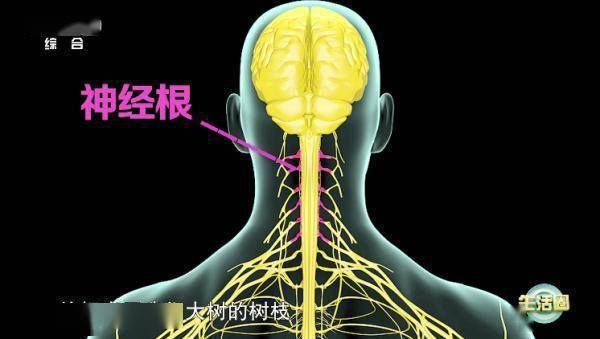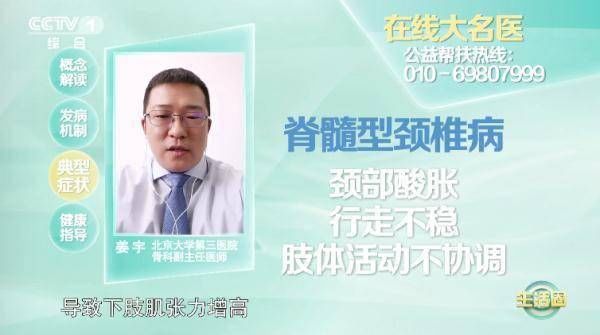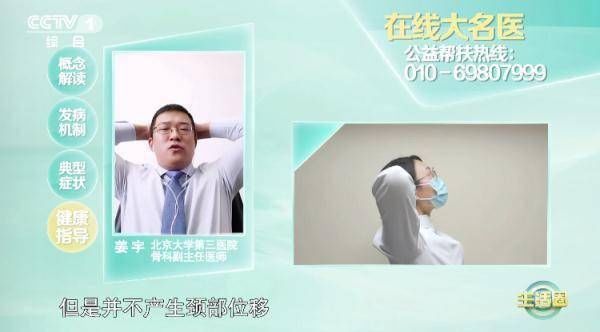This article is reprinted from: Guangming.com
67-year-old Mr. Zhang
In the past 2 months, he found that his shoulder and neck are sore and painful
The neck also Feeling very stiff
After that, my hands and feet became numb and weak
And there was severe tremor, almost unable to walk
The doctor found that Mr. Zhang was
Cervical degenerative changes
Is cervical degenerative changes related to age?
How to prevent cervical spondylosis in life?
Jiang Yu
Peking University Third Hospital
Deputy Chief Physician, Department of Orthopedics
Is cervical degenerative changes related to age?
Degenerative degeneration of the cervical spine is closely related to age, just like graying hair and wrinkles on the face, our cervical spine not only has bones, but also related muscles and ligaments, and these muscles and ligaments , including our intervertebral disc tissue will also degenerate with age and overuse, that is, cervical degenerative changes.
Some people may also experience cervical degenerative changes in advance due to overuse, decompensation, and self-repair problems. Cervical degenerative changes are not diseases in themselves, only the corresponding symptoms appear, such as cervical spondylosis, which is a symptom caused by the degeneration of the cervical intervertebral disc and the compression of nerves and peripheral blood vessels.
Is nerve compression by nucleus pulposus the most serious consequence of cervical degenerative changes
?
A very important structure in the cervical spine is the intervertebral disc of the cervical spine. It is composed of our annulus fibrosus and the nucleus pulposus in the intervertebral disc. The nucleus pulposus is actually a kind of water-rich, mucin and Structure of proteoglycan tissue.
Young people’s intervertebral discs, especially the nucleus pulposus, are rich in water, just like steamed buns, with thin skin and juicy fillings, but with age , daily excessive use, the height of the intervertebral disc will also decrease, so the water in the nucleus pulposus will gradually lose, just like the steamed buns after a period of time, the soup inside shrinks, the buns become flat, if the buns break the filling inside If the child leaks out of the bun, it is equivalent to the nucleus pulposus breaking through the annulus fibrosus and entering the spinal canal. There are very important nerve tissue in the spinal canal, if the nerve tissue is compressed, it will produce a series of serious consequences such as cervical spondylosis.
What are the symptoms of nerve compression by the nucleus pulposus?
The nerve compression of the nucleus pulposus produces different symptoms depending on the location of the compressed nerve. There are actually four types of cervical spondylosis.
Cervical radiculopathy:

The incidence rate is the highest, and the area of compression is equivalent to the nerve root For example, the nerve root is equivalent to the branch of a big tree, and the spinal cord is equivalent to the trunk. If the branch is compressed, it is equivalent to compressing our nerve root, which will cause paresthesia in the nerve root innervation area or muscle innervation area. Decreased muscle strength.
Early symptoms of cervical radiculopathy: neck pain, soreness and discomfort, as the compression time prolongs, the condition aggravates, which may cause pain and numbness in the upper extremities, and even the corresponding dominance area. Decreased muscle strength.

Cervical spondylosis:
Cervical spondylosis is all types of cervical spondylosis One of the most serious consequences. Just like the old gentleman in the case, he has cervical spondylosis.
Cervical spondylotic myelopathy is actually the protrusion of the nucleus pulposus into the spinal canal, compressing the spinal cord. In the early stage, in addition to neck discomfort and soreness, it also compresses the spinal cord, resulting in increased muscle tension in the lower limbs, unstable walking, uncoordinated limb movements, weakness in walking, and even a sense of trunk girdle, weakness in urination and defecation, and weakness in upper limb movement. For example, the buttons are inflexible, the chopsticks are inconvenient, and some people can’t even write.

Sympathetic cervical spondylosis and vertebral artery cervical spondylosis are also due to cervical disc degeneration, resulting in intervertebral instability. It will stimulate the adjacent blood vessels and nerve structures, causing dizziness, blurred vision, or some dizziness symptoms caused by the stimulation and extrusion of the vertebral artery. It causes many symptoms and requires a professional doctor to combine the patient’s own To analyze the situation in detail, give specific diagnosis and treatment advice.
How to prevent cervical spondylosis in life?
Cervical spine exercise
Place your hands on the back of your head, while raising your head, use your hands to fight forward synchronously, hold for 10 seconds as 1 time, rest for 5 to 6 seconds Then do it again, about 10 times.

After doing the exercise for 10 seconds, it is found that the muscles at the back of the neck are hot, indicating that the muscles at the back of the neck have been exercised.